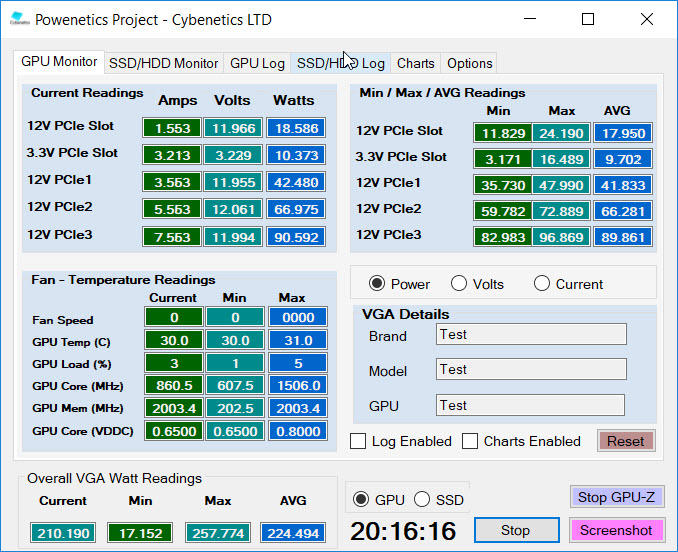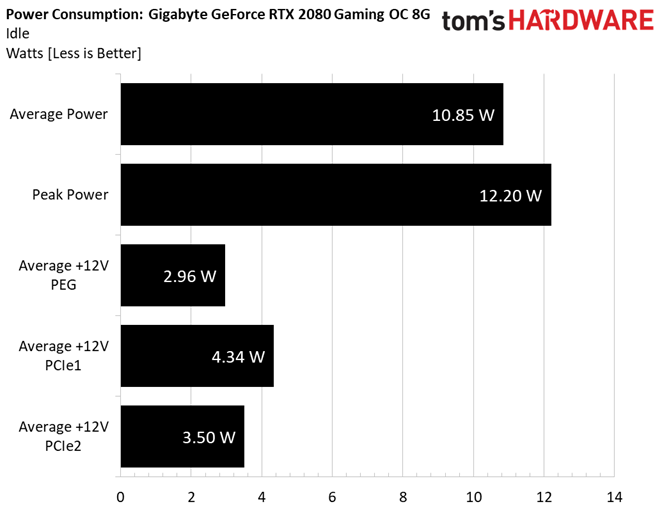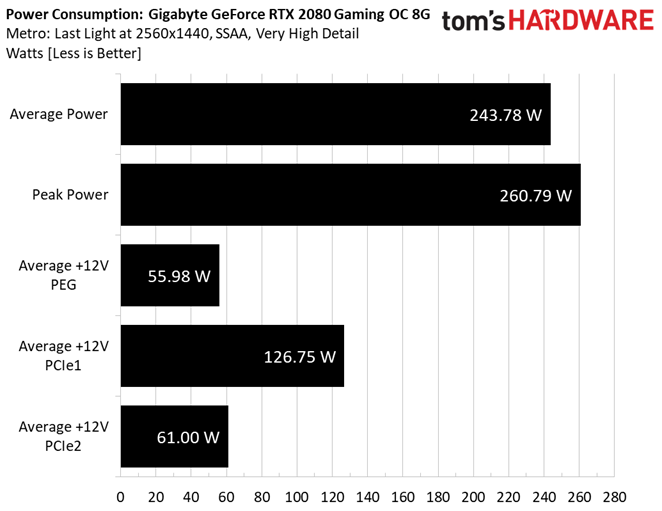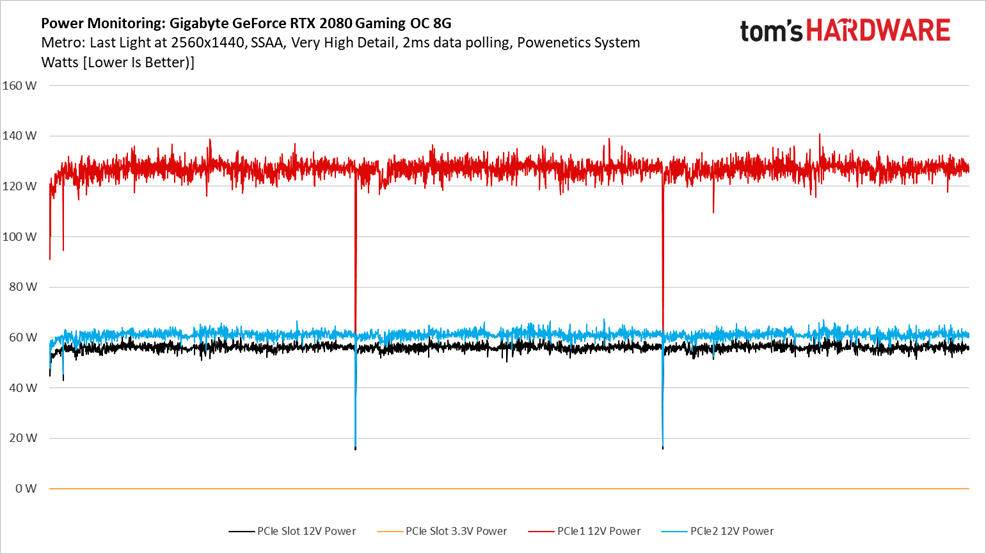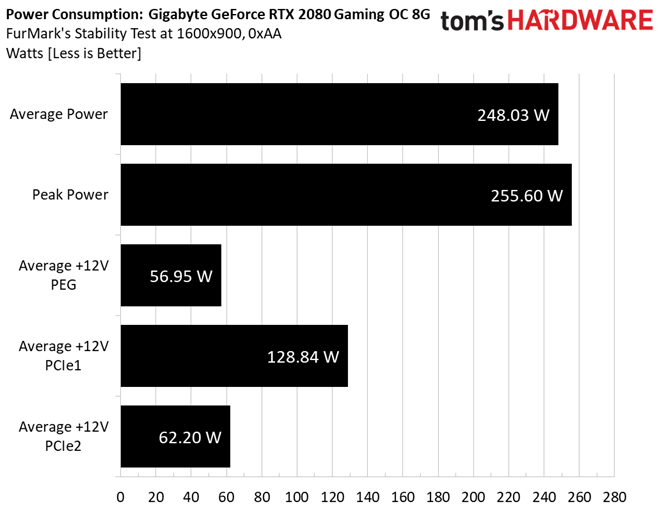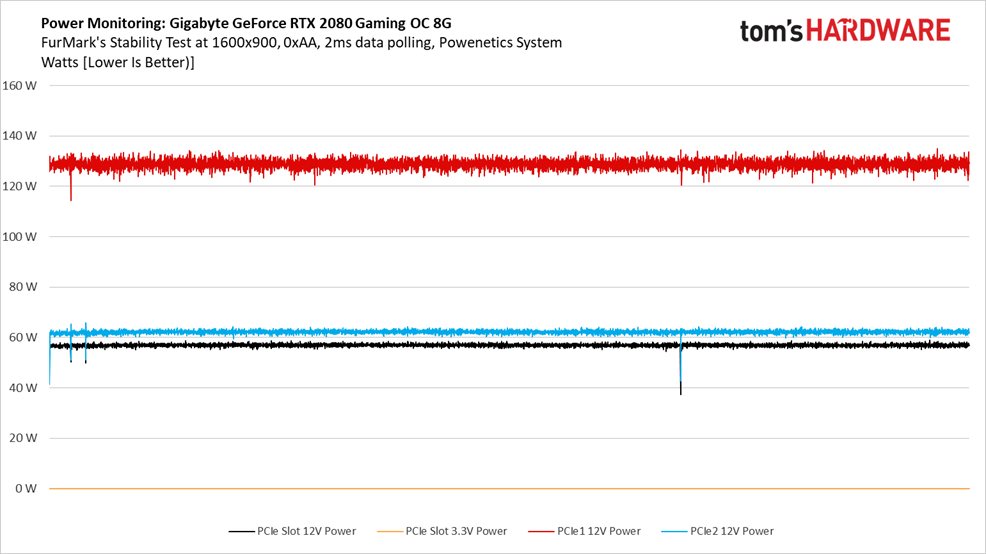Gigabyte GeForce RTX 2080 Gaming OC 8G Review: Turing Goes Semi-Passive
Why you can trust Tom's Hardware
Power Consumption
Slowly but surely, we’re spinning up multiple Tom’s Hardware labs with Cybenetics’ Powenetics hardware/software solution for accurately measuring power consumption.
Powenetics, In Depth
For a closer look at our U.S. lab’s power consumption measurement platform, check out Powenetics: A Better Way To Measure Power Draw for CPUs, GPUs & Storage.
In brief, Powenetics utilizes Tinkerforge Master Bricks, to which Voltage/Current bricklets are attached. The bricklets are installed between the load and power supply, and they monitor consumption through each of the modified PSU’s auxiliary power connectors and through the PCIe slot by way of a PCIe riser. Custom software logs the readings, allowing us to dial in a sampling rate, pull that data into Excel, and very accurately chart everything from average power across a benchmark run to instantaneous spikes.
The software is set up to log the power consumption of graphics cards, storage devices, and CPUs. However, we’re only using the bricklets relevant to graphics card testing. Gigabyte's GeForce RTX 2080 Gaming OC 8G gets all of its power from the PCIe slot, one eight-pin PCIe connector, and a six-pin PCIe connector. Should higher-end 2080 Ti boards need three auxiliary power connectors, we can support that, too.
Idle
An average idle power measurement of 10.9W is a big improvement from the 13.3W we recorded from Zotac’s Gaming GeForce RTX 2080 AMP and an even larger step forward from the GeForce RTX 2080 Founders Edition card’s 17.4W.
The first fixes for GeForce RTX’s high idle power consumption came from driver updates—specifically version 411.70. But Gigabyte’s big win comes from a semi-passive feature the company calls 3D Active Fan. At idle, the GeForce RTX 2080 Gaming OC 8G’s fans turn off completely, shaving off an extra couple of watts and facilitating silent operation.
Get Tom's Hardware's best news and in-depth reviews, straight to your inbox.
Gaming
Even using Very High quality settings, Metro: Last Light at 1920x1080 does not fully utilize a TU104 processor. Because of this, we altered our power consumption testing for GeForce RTX 2080 Gaming OC 8G to run at 2560x1440 with SSAA applied.
The result is an average power measurement of just under 244W through three loops of the game’s benchmark, with spikes more than 260W. Most of that power is delivered through the eight-pin auxiliary connector, while the PCIe slot and six-pin connector evenly divide the balance.
FurMark
Maximum utilization yields a nice, even line chart as we track more than 10 minutes under FurMark. Average power rises by about 5W compared to a real-world gaming workload. However, spikes in consumption aren’t as severe. Tom's Hardware Germany Editor Igor Wallossek observed this in our Founders Edition review, but we’ll reiterate: Nvidia does an excellent job balancing between the PCIe slot and its two auxiliary power connectors.
MORE: Best Graphics Cards
MORE: Desktop GPU Performance Hierarchy Table
MORE: All Graphics Content
Current page: Power Consumption
Prev Page Performance Results: 3840x2160 Next Page Temperatures and Fan Speeds-
PapaCrazy The subtitle on the main page cut off the word "passive" so now it just reads "Turing Goes Semi". Sly jab at the memory woes?Reply -
looprollpcservice Sorry but from what i read in your review i found that you re a little misinformed.....Reply
You re writing in cons "Triple-slot cooler takes up more space" first the gigabyte gaming 2080oc is 2.5 slot and second to that if your case is a 2 slot card, then from gigabyte you can buy rtx 2080 windforce which is a 2 slot card and is cheaper too -
cangelini Reply
A 2.5-slot cooler monopolizes three slots worth of space. If room for expansion is a priority, that makes it a con.21459851 said:Sorry but from what i read in your review i found that you re a little misinformed.....
You re writing in cons "Triple-slot cooler takes up more space" first the gigabyte gaming 2080oc is 2.5 slot and second to that if your case is a 2 slot card, then from gigabyte you can buy rtx 2080 windforce which is a 2 slot card and is cheaper too -
nabeelio Would have been helpful to have the 2070 in benchmarks, I'm trying to decide between the two.Reply
